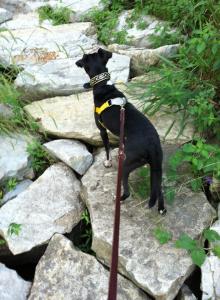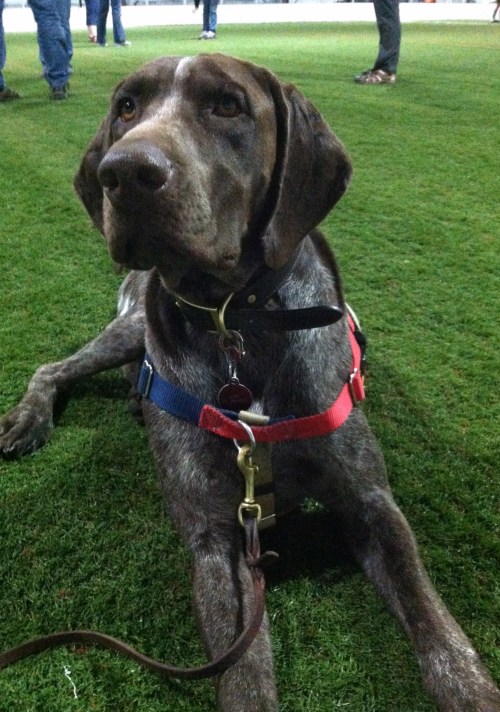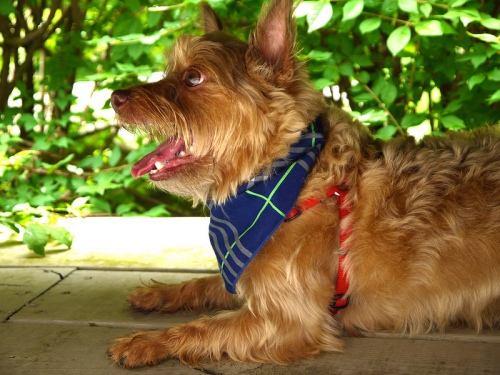Dobby’s eyes widen when he sees the new tennis ball, and he runs joyfully towards me. When I hand it to him, he arches his neck and puffs his chest out, tail held jauntily over his back as he prances around like the world’s smallest Hackney pony. His pride and joy bubble over. They infect me as he flaunts his new prize. He squeaks the ball loudly and repeatedly as his perfect little white feet rise and fall to its beat, a tiny soldier on parade with the lightning bolts on his legs flashing. I croon to him, repeating his name like a mantra. When I hold my hand down, he prances past it, rubbing his sides along my fingers with each ecstatic circle he marks out on the floor. He is electrically alive. I am holding onto this moment with everything I have, trying to live in the now like him.
I hold onto these moments, these bright sunbeams of hope, because I need something to hold onto when life with Dobby is hard. And life with Dobby is frequently hard.

Photo by SC Studios
Dobby was picked up as a stray by the Rochester City Animal Control. He was somewhere between six to twelve months old, unfixed and dirty. No one claimed him, and when his stray hold was up he was moved to the general holding area of the shelter. He clung to the back of his kennel, trembling visibly and averting his gaze when people passed by. When I slipped a leash over his neck to walk him, he pancaked to the floor and urinated.
It was obvious that he was way too frightened to assess, so those of us at the shelter that day sat with him and talked to him, coaxing him to eat treats which he mostly ignored. He froze in fear when he was touched, and kept his body low to the floor, tail touching his belly button. When we took him outside, he lit up a bit and explored, but kept a wary distance. Becca, a skilled foster volunteer, decided to bring him home.
 Under the expert care of Becca and her husband, Dobby began to blossom. He played with her dogs, and after several weeks moved in with me. Dobby began to figure out doorways, which were initially a source of great terror to him. He gained 9 pounds and 2 inches, growing into a sleek, muscular little dog. He started to seek out affection, pressing his neck and chin into the hands of those people he trusted. He learned to offer behaviors to earn rewards. He loved toys, and pranced around when given a new ball or chew toy.
Under the expert care of Becca and her husband, Dobby began to blossom. He played with her dogs, and after several weeks moved in with me. Dobby began to figure out doorways, which were initially a source of great terror to him. He gained 9 pounds and 2 inches, growing into a sleek, muscular little dog. He started to seek out affection, pressing his neck and chin into the hands of those people he trusted. He learned to offer behaviors to earn rewards. He loved toys, and pranced around when given a new ball or chew toy.
There were problems to be worked through. People in hats were terrifying, and he would lunge and snap at hands that moved too quickly around him. He became aroused very quickly but was unable to settle back down, a quivering, mouthy beast with buggy eyes ready to grab anything that moved. Quick movements and loud voices would cause him to hit the ground and pee. Housetraining took a few months, and he could not be lured with treats or toys because of his fear of hands. Reaching towards his collar terrified him.

Photo by Ryan Windfeldt
In spite of all of this, Dobby persevered. He tried his hardest and celebrated even tiny successes with his characteristic Dobby prance. Never has a dog been so full of try. He passed nine out of ten of the Canine Good Citizen test items and earned his first Rally Obedience title with comments from the judge on his joyful, prancy heel. He lit up when he was praised.
The seizures started when Dobby was somewhere between 18 to 24 months. Dobby’s eyes would glaze over and he’d stare at the ceiling with his back arched, for all the world like a dog intent on stalking a fly. A few times, he attacked whatever he saw moving as he came out of this state – me, another dog, even his own tail. After a seizure he would be tired and scared, wanting to curl up in the back of his crate and nap. They tended to come in clusters, piling on several days in a row before leaving him seizure-free for a few weeks or months.
All of Dobby’s progress vanished with the seizures, as if each seizure erased another of his newly forged neural pathways. He became fearful again, and worse yet, stress was one of his biggest seizure triggers.
 So, that’s where we’re at today. Dobby is on two seizure meds and an anxiety medication to try to control these seizures. We’re experimenting with a situational anxiety drug on top of his other medication. He’s receiving the top veterinary care at the University of Minnesota. Diet changes and changes to his routine have made no difference in his seizure activity. Even happy stress triggers seizures, so we no longer practice heelwork or play with the spring pole. He no longer attends any classes. We stopped playing tug. Dobby’s world has shrunk to a couple houses, a few walking routes, and some very careful play and training. His personality changes with each cluster of seizures, and he has become touch sensitive and cranky, likely to snap if another dog bumps him. He is introduced to new people carefully and is no longer introduced to new dogs so as not to trigger more seizures.
So, that’s where we’re at today. Dobby is on two seizure meds and an anxiety medication to try to control these seizures. We’re experimenting with a situational anxiety drug on top of his other medication. He’s receiving the top veterinary care at the University of Minnesota. Diet changes and changes to his routine have made no difference in his seizure activity. Even happy stress triggers seizures, so we no longer practice heelwork or play with the spring pole. He no longer attends any classes. We stopped playing tug. Dobby’s world has shrunk to a couple houses, a few walking routes, and some very careful play and training. His personality changes with each cluster of seizures, and he has become touch sensitive and cranky, likely to snap if another dog bumps him. He is introduced to new people carefully and is no longer introduced to new dogs so as not to trigger more seizures.
Dobby’s three to four years old at this point, and I hold on to the good days because I don’t know how many more he’ll have. I look at this gorgeous, funny, willing, sweet dog, and I think about euthanasia. I calculate percentages constantly: how many good moments is he having every day? How many bad? At what point is it no longer fair to make him keep trying in a world that is too scary and overwhelming? At what point does it become kinder to let him go, to take away the weight of living in a body which turns on itself over even minor stress? At what point is it no longer fair to my other dogs to live with an unpredictable housemate who is as likely to snap at them as to play? At what point do we stop?
I agonize and cry over this decision. I worry that compassion fatigue, a common problem with people in care-giving positions like this, is clouding my judgment. If I’m honest, living with Dobby is hard. It’s rewarding too, but it’s a constant drain to manage his environment, to set him up for success, to work with him between clusters of seizures in an effort to regain lost behavioral progress. For every step forward, there are steps back, and new challenges appear all the time. The side effects from his medication make him sleepy, hungry, and thirsty. People pile on with well-intentioned advice, clamoring for me to switch him to a raw diet, teach a new relaxation method, use Reiki, talk to an animal communicator, and try a plethora of herbal and homeopathic supplements.

Photo by SC Studios
All of this information flashes through my mind as I hand Dobby another squeaky tennis ball, one of the few things I can do to make him happy. I worry about the cost of his medication, blood work, and ever-present vet bills. I run probabilities as he burrows under the blanket when I crawl into bed at night, curling up in my arms and nestling his head under my chin to sigh deeply before drifting off to sleep. He’s warm and alive, he’s a great little dog, and I think about the finality of death.
I don’t know what I will do going forward. There are more drugs to try, more ideas to help him cope, and I want to explore them. During good moments, I delight in my little Dobby. In bad moments, when he’s scared and confused and hiding in his crate after a seizure, I feel guilty and sad. I wonder whether I’m doing more harm than good by putting him through a continuous cycle of new medication and the stress of day-to-day life. I wonder whether he wants the pain to stop. He seems so overwhelmed and scared sometimes. And through it all, he keeps trying as hard as he can to survive in a world where the deck sometimes seems stacked against him.
There’s no real conclusion to this blog post. I can’t tell you what will happen next for Dobby. I can only tell you that I want very much to do the right thing and that there’s no clear “right” thing to do.
 I’m not the only one who wrestles with this awful choice. Many of my behavioral clients have been here before with their fearful, anxious, or aggressive dogs. Some euthanize their dog, realizing that they cannot continue to ask their beloved pet to live in a world where they will never find peace. Some euthanize their dog because they cannot honestly be sure that they can keep others or themselves safe if their dog continues to live. Some resolve to manage and work with their dog for the next five or ten or fifteen years. Some dogs do not have the brain chemistry or physiology to cope with our world, and some just need training and behavior modification to successfully rewire their brain.
I’m not the only one who wrestles with this awful choice. Many of my behavioral clients have been here before with their fearful, anxious, or aggressive dogs. Some euthanize their dog, realizing that they cannot continue to ask their beloved pet to live in a world where they will never find peace. Some euthanize their dog because they cannot honestly be sure that they can keep others or themselves safe if their dog continues to live. Some resolve to manage and work with their dog for the next five or ten or fifteen years. Some dogs do not have the brain chemistry or physiology to cope with our world, and some just need training and behavior modification to successfully rewire their brain.
Regardless of the choice each of us makes, it’s a deeply personal one that’s not made lightly. It’s a heart-wrenching, gut-turning decision, whether the decision is to euthanize or to keep trying with the dog. Neither path is easy.
 We live in a society where there’s still a prevalent myth that every dog can be saved and that behavior issues are solely a result of environment rather than the complex stew of brain chemistry, development, and past history that really creates the perfect storm of an anxious, fearful, or aggressive dog. Dobby has seizures, but he also has behavioral concerns. Whether these issues are a result of his seizures or not (and I truly believe that they are, at least in part), my decision to keep working with him or euthanize is focused on his quality of life, the quality of my other dogs’ lives with him, and on the risk of keeping an unpredictable and fearful dog. The ultimate decision will be made with careful, empathetic consideration of Dobby’s happiness and the happiness of those of us (human and animal) who live with him every day.
We live in a society where there’s still a prevalent myth that every dog can be saved and that behavior issues are solely a result of environment rather than the complex stew of brain chemistry, development, and past history that really creates the perfect storm of an anxious, fearful, or aggressive dog. Dobby has seizures, but he also has behavioral concerns. Whether these issues are a result of his seizures or not (and I truly believe that they are, at least in part), my decision to keep working with him or euthanize is focused on his quality of life, the quality of my other dogs’ lives with him, and on the risk of keeping an unpredictable and fearful dog. The ultimate decision will be made with careful, empathetic consideration of Dobby’s happiness and the happiness of those of us (human and animal) who live with him every day.
So I walk the tightrope of Dobby’s life with him, helping him succeed and drinking his joy in. He watches me earnestly, my sincere, awkward, special little dog with the lightning-striped legs. I don’t have any answers, so for today a new squeaky tennis ball will have to do.

























